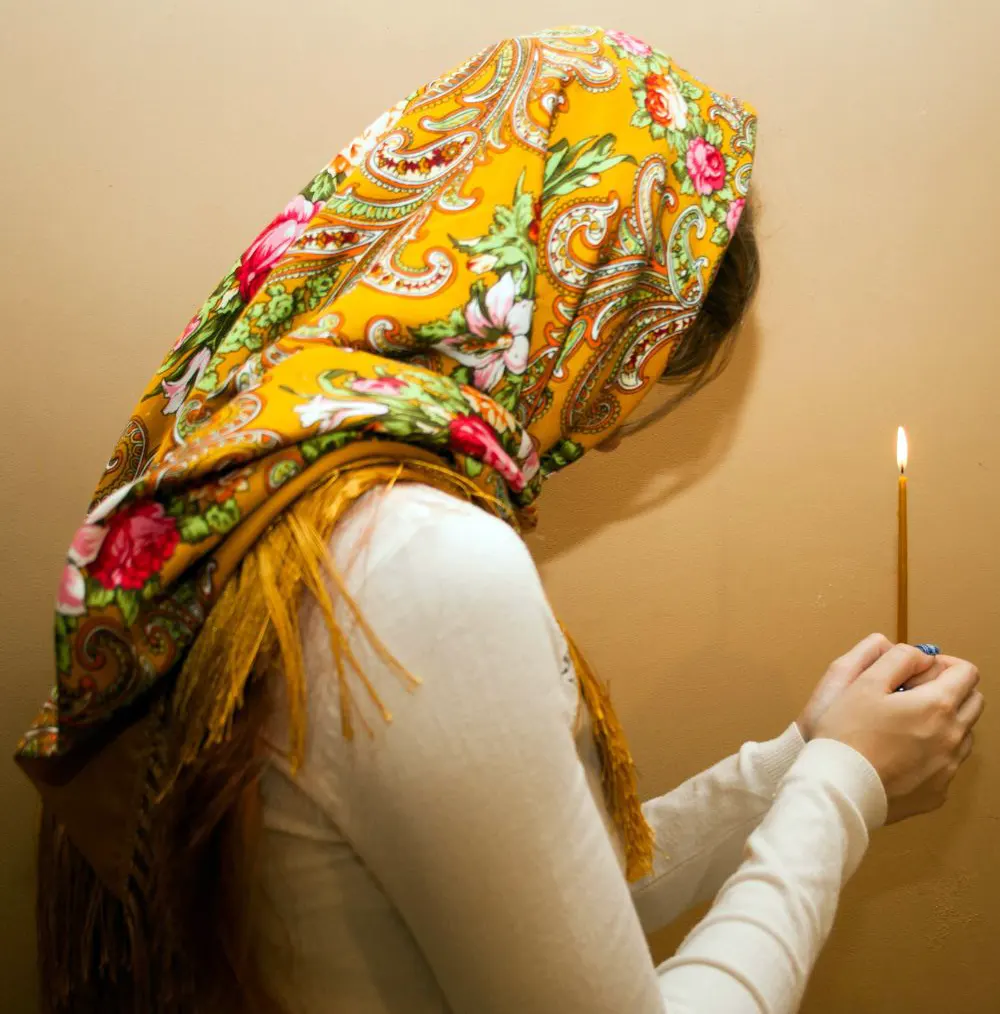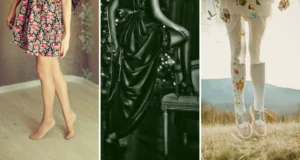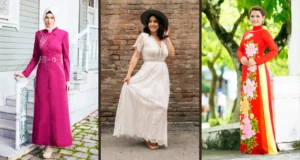Hasidic women are often recognized for their distinctive head coverings, which include wigs called sheitels. But why do they wear them? For married Hasidic women, covering their hair is seen as a way to display modesty and obedience to religious tradition.
The practice has a long history dating back to the Talmudic and medieval periods. Today, most Hasidic women wear sheitels that resemble their natural hair, allowing them more freedom of movement and a more “normal” hairstyle while still adhering to the custom of covering their natural hair from public view.
The shared goal of all hair coverings for Hasidic women is to ensure their hair remains unseen in public, demonstrating submission to religious guidelines on modesty and propriety.
Why do Hasidic females wear wigs?
Hasidic women wear wigs after marriage as an act of modesty and adherence to religious tradition. Covering their own natural hair is seen as a way for married women to obey religious customs in a respectful manner.
Hasidic Jewish custom has dictated that married women cover their hair publicly for centuries. The community’s founders believed this demonstrates a woman’s virtue, submission to religious rules, and commitment to living a modest life.
In the past, many Hasidic women cut off all their hair after marriage and wore head coverings instead of wigs.
Today, most married Hasidic women wear wigs called sheitels that resemble their natural hair. Compared to caps and headscarves, wigs allow women more freedom of movement and a more “normal” hairstyle. But they still obey the custom of covering their biological hair from public view.
Wearing sheitels primarily shows compliance with traditional norms that a married Hasidic woman’s hair should only be seen by her husband. The community believes women’s hair has special privacy within marriage and must be concealed from others.
Hasidic society strongly values modesty and restraint, shown by obeying rules like wearing wigs after marriage.
Many Hasidic women see wearing a sheitel as practically and symbolically demonstrating their devotion to tradition and faithfulness to their community’s moral code. It signifies they have taken the important step of committing to a Hasidic lifestyle upon marriage.

While some Jewish legal authorities permit wigs, others forbid them. But for most Hasidic women today, wearing a sheitel after marriage has become an entrenched religious-cultural convention.
It expresses their religious identity as part of an Orthodox way of life that demands separation from the secular world and strict rules governing women’s appearance. Wearing a wig shows they prioritize being a modest Hasidic wife and mother above following their own preferences.
In summary, Hasidic women wear wigs after marriage as a sign of religious devotion and obedience.
By conforming to the custom of covering their hair for the rest of their lives, they demonstrate their dedication to conservative Hasidic values of female modesty, dignity, privacy, and respect for religious tradition.
Why do Hasidic females shave their heads?
Some Hasidic Jewish women shave their heads after they marry as an extreme act of modesty in compliance with religious customs. Covering one’s hair is seen as important, and shaving removes all hair so it can never be accidentally revealed.
For married Hasidic women, Orthodox Jewish law says their hair must always be covered except for their husbands. Some take the strictest view that if a woman has no hair, it absolutely can never be improperly revealed.
So these women shave their heads bald as the surest way to comply with the rule.
Shaving one’s head makes it impossible for any hair to be visible to others. Hasidic women who take this step want to demonstrate the utmost commitment to rules requiring women to cover their hair.
They see shaving as a radical act of piety, ensuring their beauty and sexuality remain completely private, unseen by anyone but their husband.
Hasidic women who shave their heads view it as a way to make a clean break from being single. It marks a new stage in life as a married woman devoted to upholding moral traditions. Shaving symbolizes they have let go of the past and now belong to their husband alone.
However, most Hasidic women do not shave their heads. Many simply cover their hair with scarves, hats, or wigs. Each woman makes her own choice based on her beliefs and priorities, and varying levels of hair covering are deemed acceptable.
The Satmar Hasidic group commonly practises head shaving, though some women in other communities also do it. Women typically shave on the day after their wedding and then continue regularly to prevent even the tiniest hair growth from becoming visible.
While shaving one’s head ensures hair is never seen, some criticize the practice. They argue shaving is painful, harmful to women’s self-image, and reduces married women to physical objects meant to be hidden.
Still, Hasidic women who shave see it as an ultimate expression of piety and propriety. By removing all traces of vanity or sexual allure, they demonstrate their singular commitment to living strictly according to the most conservative religious customs.
For these women, their intense devotion to hiding their womanhood and beauty reflects their total embrace of Hasidic values.
What is the history behind the tradition of covering women’s hair in Judaism?
The tradition of covering women’s hair in Judaism has a long history stretching back over two thousand years. Though not required in the Bible itself, the practice gradually developed during the Talmudic and medieval periods as a sign of modesty and compliance with norms of propriety.
Covering hair in public became customary for married Jewish women to shield their beauty and intimacy from the outside eyes. Halachic sources from the Talmud state that “a woman’s hair is her glory” and should be covered.
While the Bible does not explicitly mandate veiling hair, Jewish sages during Talmudic times interpreted various biblical passages as supporting the modest practice.
Over time, covering one’s hair came to be seen as a religious-cultural marker of Jewish and specifically married status. Unveiled hair signaled a woman was not married and, therefore, immodest.
Distinctive headdresses helped Jewish women maintain a unique outward identity within the larger non-Jewish society.
Married Jewish women generally covered their hair with a cloth or veil during the medieval period. In the sixteenth century, as Hasidism spread, sheitels or wigs became popular alongside headscarves. Though allowing for more femininity, the wig still ensured a woman’s real hair remained private.

Today, Orthodox Jewish women utilize various forms of head coverings after marriage, including wigs, hats, and scarves, and some go as far as shaving their heads to guarantee no hair is ever seen.
Yet not all Jewish women cover their hair, and the practice remains a matter of individual choice rather than a commandment.
In summary, the custom for married Jewish women to veil their hair gradually arose as a symbol of female modesty, sexual propriety, and cultural identity.
Based more on rabbinic interpretation than biblical law, the tradition has still been widely observed for centuries among Orthodox communities as an expression of religious devotion and adherence to traditional Jewish norms regarding womanhood.
What are the other ways Hasidic women keep their hair covered?
In addition to wearing wigs, Hasidic women keep their hair covered in various other ways to comply with religious customs requiring married women to hide their hair.
The most frequent method is a tied scarf, a tichel worn tightly over all hair. Tichel scarves can be made of different materials like silk, cotton, or wool and come in plain or decorative styles. They completely cover the hair while allowing freedom of movement.
Some women wear snoods, small, fitted caps that tightly enclose all hair. Snoods are usually made of thin silk or cotton and often get placed beneath a scarf or tichel.
Occasionally Hasidic women put on hats to veil their hair though hats are less popular than scarves or wigs. Hats can be made from felt, straw, or fur in plain or embellished designs.
Other women cover their hair using nylon or silk hairnets worn under a wig or scarf. Hairnets ensure hair stays in place and does not accidentally reveal.
While wigs called sheitels remain the norm, some Hasidic women wear scarves, snoods, hats, or hairnets depending on personal inclination and their community’s conservative customs.
More stringent communities typically demand constant hair covering, while less strict groups may allow exceptions at home.
Regardless of the method, Hasidic women prioritize covering their hair. They tie on the tichel scarf, pull on the snood cap, position the hat, or test the security of hairnets to confirm their hair stays properly hidden.
Their choice of covering reflects a dedication to traditions requiring married women to shield their hair from any male eyes but their husbands.
So though Hasidic women have options, the shared goal uniting all choices is ensuring their hair remains unseen in public, demonstrating submission to religious guidelines on modesty and propriety.
What is the difference between a Sheitel and a wig?
The terms “sheitel” and “wig” are often used interchangeably, but there are some key differences between a sheitel and a regular wig. A sheitel refers specifically to a wig worn by Orthodox Jewish women for religious purposes, while a wig can be worn for any reason.
A sheitel is made from real human hair that was ethically sourced according to Jewish laws. The women who donated the hair did so willingly to provide sheitels for Orthodox Jewish women.
On the other hand, regular wigs can be made from any type of hair and are not necessarily produced in an ethically or religiously sanctioned way.
Although a sheitel and a regular wig may look and function similarly from the outside, there are important distinctions for the women who wear them.
A sheitel allows an Orthodox Jewish woman to comply with the religious requirement of covering her hair after marriage while still expressing her feminine qualities. The sheitel gives the woman a sense of privacy and modesty, even though others may just see it as a normal wig.
Sheitels are often designed in styles that closely mimic natural hair, with heavy bangs that hide the wearer’s natural hairline. This creates the illusion that the woman’s hair is her own.
On the other hand, regular wigs can be styled in a wider range of ways that are not as concerned with appearing natural.

Many sheitels also undergo a hechsher, or kosher certification, to ensure the hair meets Jewish rules regarding idolatry. This is because some sheitels in the past were made with hair that was donated as part of non-Jewish religious rituals.
In summary, while a sheitel and a regular wig may appear and function similarly, there are crucial differences in their meaning and purpose. A sheitel allows an Orthodox Jewish woman to express external beauty while maintaining internal religious observance and a sense of privacy and modesty.
Summary
Hasidic women cover their hair after marriage as an act of modesty and obedience to religious tradition. They wear wigs called sheitels that resemble their natural hair, allowing them more freedom of movement.
Some shave their heads as an extreme act of piety. The tradition of covering women’s hair in Judaism has a long history, and various forms of head coverings are utilized today, including scarves, snoods, hats, and hairnets.
The difference between a sheitel and a regular wig is that a sheitel is made from real human hair that was ethically sourced according to Jewish laws, while a regular wig can be made from any hair and is not necessarily produced in an ethically or religiously sanctioned way.
FAQ
Can you make a sheitel from your own hair?
Yes, it is possible to make a Sheitel from your own hair. According to most Poskim (Jewish legal authorities), making a Sheitel even out of your own hair is permitted. The Pri Magadim, a commentary on the Shulchan Aruch, permits the use of a Sheitel, and the Mishna Berurah states that it is indicative in the language of the Pri Magadim that he permits the use of one’s own hair in the manufacture of it as well.
Do unmarried Jews cover their hair?
In Judaism, the tradition of covering hair is generally associated with married women as a sign of modesty and compliance with traditional notions of propriety. However, there is some debate among halakhic authorities about whether unmarried women should also cover their hair. According to the Talmud, Jewish women should not walk in the marketplace with uncovered hair, which applies to both unmarried and married women. However, some rabbis believe that unmarried women do not have to cover their hair, while others believe they should cover their hair to some extent.
Can Jews cut pubic hair?
According to Jewish law, it is forbidden for a man to remove his armpit hair or his pubic hair, even by using scissors to shave the hair to a razor-like cut. However, according to the Ben Ish Hai Rav Pealim section 4 Sod Yesharim question 5, one is allowed to trim pubic hair (and really any hair) as long as it is done in a way where the root of the hair remains.
Can Jews braid their hair?
From a religious perspective, there are some restrictions on braiding hair on the Sabbath, as it is considered a form of work and is therefore prohibited. However, outside of the Sabbath, there are generally no restrictions on braiding hair within Jewish law.
How much does sheitel cost?
The cost of a Sheitel can vary depending on factors such as the quality of the hair used and the length, color, and style of the wig. Sheitels typically range from $1,300 to $4,500.




